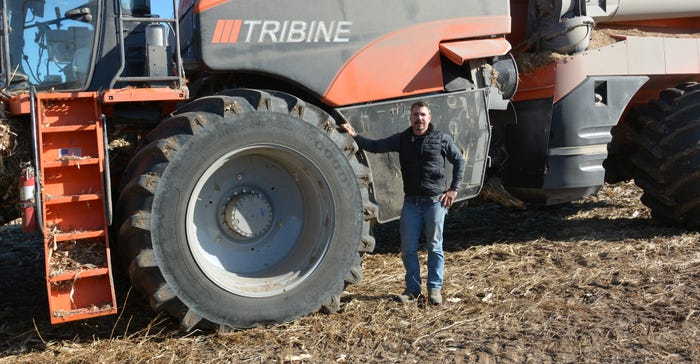
A LITTLE DUSTY: Field test engineer Ray Price was driving the Tribine T1000 at the Garetson Brothers farm near Copeland, Kan., on Nov. 6.
It’s been a frustrating harvest at Garetson Farms near Copeland in southwest Kansas, where the annual challenges typically involve lack of rain and water rights for irrigation. This year, it’s been about too much rain and a harvest coming down to the wire with snow in the forecast.
"First, there was the big rain and flooding. We had to wait for fields to dry out. Then, every time we were ready to start, it rained again," says Jay Garetson, who farms with his brother, Jarvis.
"I never want to complain about moisture because we need all we can get, but it sure has made for a frustrating year," he says.
On Nov. 6, however, harvest was in full swing. Two new production model Tribines were running at full speed, along with one John Deere combine and two tractors and grain carts.
The Garetsons are among the first customers for Tribine Harvester, which opened manufacturing operations in Newton, Kan., just a couple of years ago.
This year, the Garetsons have been working with field test engineer Ray Price, who has been making tweaks and taking notes on the go.
"We’re still in the learning process. The idea is to make sure that we get this right for the customer," Price said. "The Garetsons have been great to work with."
Jay says he chose to invest in the Tribine because he sees the unique features the machine offers as providing him the potential to shave pennies per bushel off his harvesting costs.
He chose to be an initial customer for the opportunity it offers him to be part of the team bringing a new product to market.
"I like the idea that it is built in Kansas," he says. "And I like the idea that the company is willing to make it possible for me to have the parts, diagnostics and training to maintain it on the farm. And I like that it is designed by farmers, for farmers."
The Tribine’s 1,000-bushel bin fills a semi and its powerful augers empties the bin at the rate of 500 bushels a minute. For the Garetsons, that means eliminating the need for a tractor and grain cart to dump the combine bin on the go.
"That’s less machinery to buy and maintain," Jay says. "And less labor needed. You can run two Tribines with two operators. With combines and grain carts, you need two combine operators and two tractor drivers."
It also means less traffic in the field and less yield-robbing compaction, he said. The Tribine rides on four Goodyear 1100/45R46 low sidewall technology tires with up to 40% lower inflation pressure.
"You get noticeably less compaction and rutting in wetter weather like we’ve had this year," Jay says.
For his no-till farming operation, Jay says he appreciates the dual, side residue discharge which evenly distributes residue up to 25 feet on each side of the harvester.
"You really get the residue spread out over the field," he says.
Jay says he also likes the center articulation and all-wheel drive, which makes it easy to turn and easy to maneuver.
The Tribine can interface with most headers from other OEMs.
"It’s built to interface with the John Deere header, but there are after-market kits that make it compatible with most 18-row headers, or the 45-foot flex draper heads," Price says.
From concept, to design, to production
Indiana farmer Ben Dillon has been thinking about how to design a better combine for decades. Now, he’s building the first really new combine design to be offered since self-propelled machines were introduced in the 1940s. Dillon is the owner and president of Tribine.
"We wanted to position the headquarters where our customers area," says Greg Terjesen, vice president for sales and marketing. "Kansas, Nebraska, Iowa, Indiana and Illinois are what we see as the bulk of our market. And this area has a good supply of engineers and manufacturing labor force."
Terjesen says Tribine works with a number of suppliers and vendors in smaller shops across central Kansas.
"We’re proud that we contribute to the economy of Kansas and that our machines are 100% built in the USA," says James Shurts, chief operating officer.
Initially, the company was not able to accept a trade-in combine from a customer who wanted to purchase a Tribine, Tejesen says. However, the company has now worked out a program and is accepting trades, he says.
Just as the Tribine is a new combine design from the ground up, the business model for the company takes a new approach to farm machinery sales, Shurts says.
The company is farmer-focused, with Dillon, Shurts and about half of the engineering staff also engaged in farming operations. Shurts Farms is a cow-calf and row crop operation near Beloit. His father and brother handle day-to-day management of the farm, with Shurts providing administrative and management support.
The business model is built on direct sales to customers, with farmers being trained to do their own maintenance.
"We have no desire to set up dealerships," Shurts says. "It is a simple, practical technology. There’s no reason that a farmer wouldn’t be able to maintain it."
He says the plan is to work closely with initial customers so they can be a resource to their neighbors who might buy a machine in the future.
The company also plans to stay small and targeted, at least in its first years. Tribine has set a goal to sell 10 machines next year.
"We have modest expectations," Terjesen says. "We want to assure that we meet our commitment to our customers."
About the Author(s)
You May Also Like




